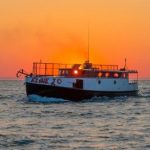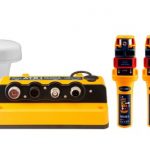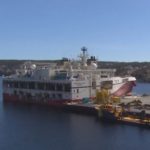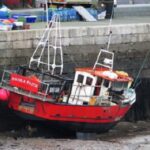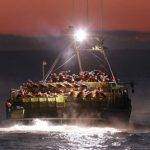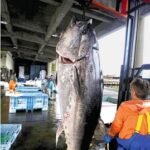Category Archives: National
Report portrays mixed picture of Alaska’s huge seafood industry
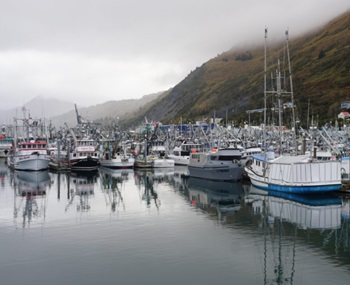 The report from the McKinley Research Group, titled The Economic Value of Alaska’s Seafood Industry, is the latest in a periodic series commissioned by the Alaska Seafood Marketing Institute. The total economic value of the Alaska seafood industry in 2021 and 2022 was $6 billion, slightly more than the $5.6 billion tallied in 2019, the last full year prior to the COVID-19 pandemic, according to the new report and the previous version published in 2022. Along with that good news, the McKinley Research Group’s report contains a warning about the industry’s economic future. The seafood industry, between harvesters, processors and managers, accounted for 48,000 jobs on average in 2021 and 2022, equivalent to 29,100 full-time positions, the report said. That is a reduction from the 62,200 total jobs in 2019, the equivalent of 37,400 full-time positions. more, >>CLICK TO READ<< 11:21
The report from the McKinley Research Group, titled The Economic Value of Alaska’s Seafood Industry, is the latest in a periodic series commissioned by the Alaska Seafood Marketing Institute. The total economic value of the Alaska seafood industry in 2021 and 2022 was $6 billion, slightly more than the $5.6 billion tallied in 2019, the last full year prior to the COVID-19 pandemic, according to the new report and the previous version published in 2022. Along with that good news, the McKinley Research Group’s report contains a warning about the industry’s economic future. The seafood industry, between harvesters, processors and managers, accounted for 48,000 jobs on average in 2021 and 2022, equivalent to 29,100 full-time positions, the report said. That is a reduction from the 62,200 total jobs in 2019, the equivalent of 37,400 full-time positions. more, >>CLICK TO READ<< 11:21
The 100% Fish Project: More Than Just a Filet of Fish
 Dave Naftzger found out about the 100% Fish Project entirely by accident. He was headed to Europe on a business trip, but first had a long layover in Iceland. So, he did some research to see what he could do while he was there. That’s when he came across a project where people had figured out how to use and sell almost 100% of every fish they caught, specifically Atlantic cod, Iceland’s most iconic fish. Dave is the executive director of the Conference of Great Lakes and St. Lawrence Governors and Premiers, an intergovernmental organization, and this caught his attention. He set up a meeting with the main guy, Thor Sigfusson. “Walked into his office, he had a fish skin, fish leather lamp,” said Dave. “And he had a table with all these different products that would be made from parts of the Icelandic cod that used to be put in landfill. It really was inspirational.” Photos, more, >>CLICK TO READ<< 08:46
Dave Naftzger found out about the 100% Fish Project entirely by accident. He was headed to Europe on a business trip, but first had a long layover in Iceland. So, he did some research to see what he could do while he was there. That’s when he came across a project where people had figured out how to use and sell almost 100% of every fish they caught, specifically Atlantic cod, Iceland’s most iconic fish. Dave is the executive director of the Conference of Great Lakes and St. Lawrence Governors and Premiers, an intergovernmental organization, and this caught his attention. He set up a meeting with the main guy, Thor Sigfusson. “Walked into his office, he had a fish skin, fish leather lamp,” said Dave. “And he had a table with all these different products that would be made from parts of the Icelandic cod that used to be put in landfill. It really was inspirational.” Photos, more, >>CLICK TO READ<< 08:46
Dockside Safety Exam Program – Coast Guard helps commercial fishermen ensure a safe catch
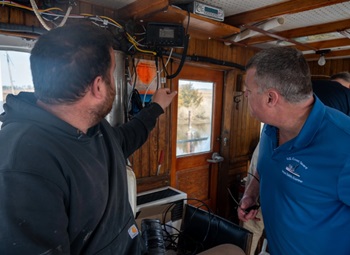 As the nation’s largest estuary, the Chesapeake Bay is a highly valued resource for more than 18 million people who live in its watershed. Producing about 500 million pounds of seafood each year, the Bay supports commercial and recreational fishing and creates one of the most economically significant regions of the Unites States. According to NOAA and the U.S. Bureau of Labor Statistics, commercial fishing is one of the country’s most dangerous occupations. “What we do for the local fishing community is support their workplace safety,” said Timothy Diehl, a Coast Guard vessel safety examiner from Sector Maryland-National Capital Region in Baltimore, Maryland. Most of Diehl’s workdays are spent traveling to area marinas where he meets with commercial fishing vessel operators and owners. Photos, more, >>CLICK TO READ<< 07:21
As the nation’s largest estuary, the Chesapeake Bay is a highly valued resource for more than 18 million people who live in its watershed. Producing about 500 million pounds of seafood each year, the Bay supports commercial and recreational fishing and creates one of the most economically significant regions of the Unites States. According to NOAA and the U.S. Bureau of Labor Statistics, commercial fishing is one of the country’s most dangerous occupations. “What we do for the local fishing community is support their workplace safety,” said Timothy Diehl, a Coast Guard vessel safety examiner from Sector Maryland-National Capital Region in Baltimore, Maryland. Most of Diehl’s workdays are spent traveling to area marinas where he meets with commercial fishing vessel operators and owners. Photos, more, >>CLICK TO READ<< 07:21
Graves, Wicker Urge NOAA to Catch Better Data for Fisheries Management
 U.S. Congressman Garret Graves and U.S. Senator Roger Wicker – along with U.S. Senate Commerce Committee Ranking Member Ted Cruz (Texas), U.S. House Natural Resources Committee Chair Bruce Westerman and 20 other bipartisan Members of Congress – urged the National Oceanic and Atmospheric Administration (NOAA) Assistant Administrator Janet Coit to modernize the data used by the National Marine Fisheries Service (NMFS) and bring better science to the table for fisheries management. “Historically, the federal government’s fisheries data management has been a failure. Their system overestimates what has been caught, which gives us less opportunity to fish. There are real solutions on the table to reverse this trend .“We know that there’s better and more precise fisheries management data being collected by the states than what the federal government can provide, and we want NMFS to use the best data and science,” said Congressman Graves. “Our children and grandchildren deserve sound science and sustainable fisheries management. more, >>CLICK TO READ<< 09:23
U.S. Congressman Garret Graves and U.S. Senator Roger Wicker – along with U.S. Senate Commerce Committee Ranking Member Ted Cruz (Texas), U.S. House Natural Resources Committee Chair Bruce Westerman and 20 other bipartisan Members of Congress – urged the National Oceanic and Atmospheric Administration (NOAA) Assistant Administrator Janet Coit to modernize the data used by the National Marine Fisheries Service (NMFS) and bring better science to the table for fisheries management. “Historically, the federal government’s fisheries data management has been a failure. Their system overestimates what has been caught, which gives us less opportunity to fish. There are real solutions on the table to reverse this trend .“We know that there’s better and more precise fisheries management data being collected by the states than what the federal government can provide, and we want NMFS to use the best data and science,” said Congressman Graves. “Our children and grandchildren deserve sound science and sustainable fisheries management. more, >>CLICK TO READ<< 09:23
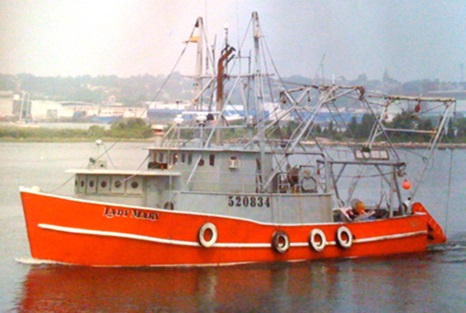
Fishing Vessel Lady Mary Remembered 15 Years After Sinking
On March 18, 2009, the F/V Lady Mary, a 71-foot scallop boat, left Cape May Harbor for the scalloping grounds in an area known as the Elephant’s Trunk, roughly 60 miles from Cape May. The crew had nearly completed its catch when, between 5:19 and 5:39 a.m. on March 24, the boat sank. Six of the seven crew members were lost. Over the next four years, the Coast Guard and the National Transportation Safety Board completed investigations into the sinking, concluding there were multiple factors responsible. The Coast Guard filed its report on Aug. 23, 2013, saying the Lady Mary did not capsize, nor did it sink due to a fire or explosion. Despite the reported nearby presence of a container vessel named the Cap Beatrice, the Coast Guard concluded there was no evidence that any other vessel was at fault for the chain of events that eventually led to the sinking. Photos, more, >>CLICK TO READ<< 07:35
Biden administration plans to tee up offshore wind across the nation’s coastlines
 The Biden administration is planning to boost offshore wind energy production, announcing up to a dozen opportunities for industry to bid on chances to build wind turbines in U.S. oceans over the next five years. Interior Secretary Deb Haaland is slated to announce the lease sales at a conference in New Orleans. The 12 potential opportunities Haaland is announcing include sales in the central Atlantic Ocean, Gulf of Maine, Gulf of Mexico, the New York Bight and off the coast of Oregon, California, Hawaii and a yet-to-be-determined U.S. territory. These sales were described as potential sales that could occur rather than ones definitely slated to happen, and if former President Trump wins election, he may want to cancel them. more, >>CLICK TO READ<< 14:56
The Biden administration is planning to boost offshore wind energy production, announcing up to a dozen opportunities for industry to bid on chances to build wind turbines in U.S. oceans over the next five years. Interior Secretary Deb Haaland is slated to announce the lease sales at a conference in New Orleans. The 12 potential opportunities Haaland is announcing include sales in the central Atlantic Ocean, Gulf of Maine, Gulf of Mexico, the New York Bight and off the coast of Oregon, California, Hawaii and a yet-to-be-determined U.S. territory. These sales were described as potential sales that could occur rather than ones definitely slated to happen, and if former President Trump wins election, he may want to cancel them. more, >>CLICK TO READ<< 14:56
Predators take big bite out of declining Atlantic mackerel population
 Predators ate at least twice as many Atlantic mackerel as commercial fishery landings in the decade leading up to Canada’s region-wide moratorium, according to new research by Canadian and American scientists. The study also found seals are a major predator, lending credence to what many fishermen have long claimed. The modelling study was published this month by the federal Fisheries Department and the Canadian Science Advisory Secretariat. The top predators were gannets, grey seals, dogfish and bluefin tuna. In the most conservative estimate, predators removed between 21,000 and 29,000 tonnes annually between 2012 and 2021 — at least two times greater than Canadian commercial landings reported as 11,000 tonnes per year. more, >>CLICK TO READ<< 12:26
Predators ate at least twice as many Atlantic mackerel as commercial fishery landings in the decade leading up to Canada’s region-wide moratorium, according to new research by Canadian and American scientists. The study also found seals are a major predator, lending credence to what many fishermen have long claimed. The modelling study was published this month by the federal Fisheries Department and the Canadian Science Advisory Secretariat. The top predators were gannets, grey seals, dogfish and bluefin tuna. In the most conservative estimate, predators removed between 21,000 and 29,000 tonnes annually between 2012 and 2021 — at least two times greater than Canadian commercial landings reported as 11,000 tonnes per year. more, >>CLICK TO READ<< 12:26
‘Codfather’ boat sunk, sleeps with the fishes in artificial reef off the Jersey Shore
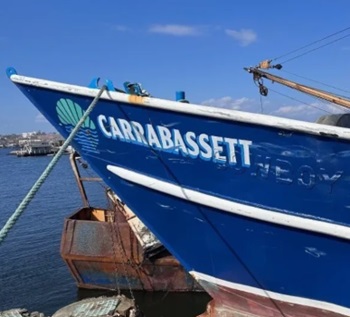 The Axel Carlson Reef off the Jersey Shore has a new structure that was once part of the fleet of the infamous “Codfather” Carlos Rafael, a commercial fisherman who went to jail for mislabeling fish in 2016. When he went to jail, his entire fleet of boats worth millions of dollars was seized by the IRS and sold off. One of those boats was the Carrabassett, a 90-foot steel dragger. It was purchased by a New England commercial outfit that ran the boat aground, cracking the hull open. The boat then caught fire at drydock and was going to go on the scrap metal market when New Jersey’s artificial reef program coordinator Peter Clarke was able to secure it in order to add it to the Axel Carlson Reef, a man-made reef that sits 2.1 miles off the coast of Point Pleasant Beach. more, >>CLICK TO READ<< 10:34
The Axel Carlson Reef off the Jersey Shore has a new structure that was once part of the fleet of the infamous “Codfather” Carlos Rafael, a commercial fisherman who went to jail for mislabeling fish in 2016. When he went to jail, his entire fleet of boats worth millions of dollars was seized by the IRS and sold off. One of those boats was the Carrabassett, a 90-foot steel dragger. It was purchased by a New England commercial outfit that ran the boat aground, cracking the hull open. The boat then caught fire at drydock and was going to go on the scrap metal market when New Jersey’s artificial reef program coordinator Peter Clarke was able to secure it in order to add it to the Axel Carlson Reef, a man-made reef that sits 2.1 miles off the coast of Point Pleasant Beach. more, >>CLICK TO READ<< 10:34
Athearn Marine Agency Boat of the Week: 68′ Steel Shrimper/Scallop Dragger, Cat 3406
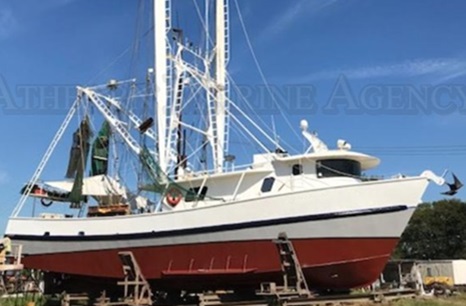 To review specifications, information, and 5 photos’, >click here<, To see all the boats in this series, >click here< 08:41
To review specifications, information, and 5 photos’, >click here<, To see all the boats in this series, >click here< 08:41
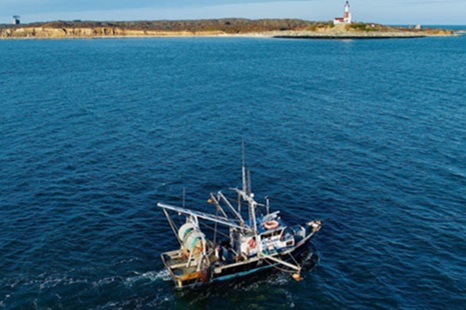
Once Sourced Out-of-State, Shrimp From New York Is Becoming a Status Ingredient
When wild shrimp is US-harvested, it’s pulled in-season from the waters off Louisiana, Texas, Florida, and the Carolinas. Increasingly, though, a select number of New York restaurants are embracing local shrimp, highlighting fisheries in and around Montauk. Long Island’s royal red shrimp is caught off Montauk at nearly 3,000 feet. “Their color is a gorgeous, gorgeous dark red; a color I’ve never seen in my life,” says lifelong fisherman, K.C. Boyle. Photos, more, >>CLICK TO READ<< 06:42
Warming Waters Heat Summer’s Feast Well Before It Gets to the Kitchen
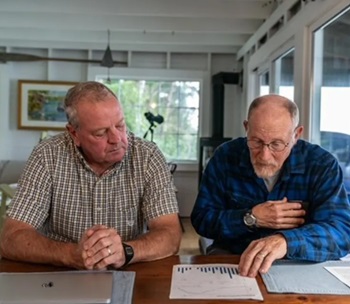 An ever-warming planet is playing havoc with the intricately interconnected web of marine life. Just as climate has long stressed human populations and driven migration, marine populations are stressed and in search of survivable climates too. In New England, scientists and lobstermen alike are studying and living the impacts. Tim Alley has been lobstering in Maine’s coastal waters for 40 years. “There’s been a trend in recent years related to temperatures,” he says. Alley is steeped in the traditions of his home state’s biggest industry and recently dusted off a short film from 1972 in which he starred at age 12, “Alone in My Lobster Boat,” filmed in South Bristol and New Harbor, Maine. Like most lobstermen, he would call himself an environmentalist: they live on the water, they live from the water, they thrive on the water. But they reject the notion that a species – the right whale – is failing because of them. Over 40 years, he says, he has seen exactly one right whale. Photos, Video, more, >>CLICK TO READ<< 14:50
An ever-warming planet is playing havoc with the intricately interconnected web of marine life. Just as climate has long stressed human populations and driven migration, marine populations are stressed and in search of survivable climates too. In New England, scientists and lobstermen alike are studying and living the impacts. Tim Alley has been lobstering in Maine’s coastal waters for 40 years. “There’s been a trend in recent years related to temperatures,” he says. Alley is steeped in the traditions of his home state’s biggest industry and recently dusted off a short film from 1972 in which he starred at age 12, “Alone in My Lobster Boat,” filmed in South Bristol and New Harbor, Maine. Like most lobstermen, he would call himself an environmentalist: they live on the water, they live from the water, they thrive on the water. But they reject the notion that a species – the right whale – is failing because of them. Over 40 years, he says, he has seen exactly one right whale. Photos, Video, more, >>CLICK TO READ<< 14:50
How the death of a mega-turbine rattled US offshore wind
 When GE Vernova confirmed that it was canceling one of the largest wind turbines ever designed, it signaled a pause in an arms race that for years had led manufacturers to go higher, longer and wider when building towers, blades and other components. Now, that decision is reverberating across U.S. efforts to build wind projects in the Atlantic. New York canceled power contracts for three offshore wind projects last week, citing GE Vernova’s decision to abandon its largest turbine model, a massive 18-megawatt machine. The timing could hardly be worse. Offshore wind is the keystone of New York’s plan to generate 70 percent of its power with renewable energy by the end of the decade.“Using the lower-capacity turbines means that each developer would need to buy 12 to 13 additional turbines to build a project of the same capacity,” Jain said. “That also means more foundations, cables, days hiring expensive installation vessels and so on, significantly raising total project cost assumptions.” more, >>CLICK TO READ<< 10:24
When GE Vernova confirmed that it was canceling one of the largest wind turbines ever designed, it signaled a pause in an arms race that for years had led manufacturers to go higher, longer and wider when building towers, blades and other components. Now, that decision is reverberating across U.S. efforts to build wind projects in the Atlantic. New York canceled power contracts for three offshore wind projects last week, citing GE Vernova’s decision to abandon its largest turbine model, a massive 18-megawatt machine. The timing could hardly be worse. Offshore wind is the keystone of New York’s plan to generate 70 percent of its power with renewable energy by the end of the decade.“Using the lower-capacity turbines means that each developer would need to buy 12 to 13 additional turbines to build a project of the same capacity,” Jain said. “That also means more foundations, cables, days hiring expensive installation vessels and so on, significantly raising total project cost assumptions.” more, >>CLICK TO READ<< 10:24
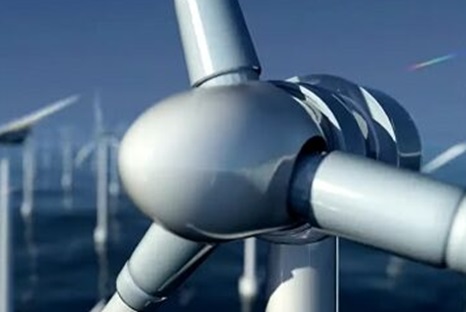
3 New York wind farms scrapped – Cost implications for Mass., Conn., and R.I.
New York pulled the plug Friday on three offshore wind projects that encountered pricing problems after GE canceled the development of a larger turbine that the developers had been counting on. The decision is a setback for the US offshore wind industry and may have some cost implications for Massachusetts, Connecticut, and Rhode Island, which are in the midst of a joint procurement for offshore wind power. The three wind farms proposed for the coast off New York were all tied to a plan by GE Vernova to start producing giant 18-megawatt turbines at a facility on the Hudson River to be subsidized by the state. more, >>CLICK TO READ<< 10:04
Major offshore wind projects in New York canceled in latest blow to industry
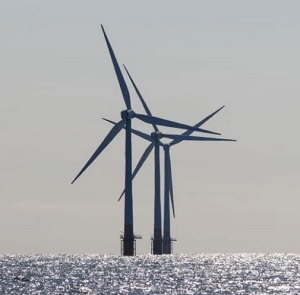 New York’s signature offshore wind projects meant to boost confidence in the industry are being scrapped, a major hit to the industry in the state and the nation. The decision is another setback to New York’s aspirations to achieve 70 percent renewable energy by 2030 and be a hub for the nascent industry in the United States. It will also be another challenge for President Joe Biden’s already likely out-of-reach 30 gigawatt goal for offshore wind by 2030. NYSERDA, the state authority in charge of the deals, announced Friday that no final agreements could be reached with the three projects that received provisional awards in October 2023. Those bids were all linked to major supply chain investments by General Electric and a larger turbine it planned to build that was aimed at boosting the region’s renewable energy portfolio. more, >>CLICK TO READ<< 16:50
New York’s signature offshore wind projects meant to boost confidence in the industry are being scrapped, a major hit to the industry in the state and the nation. The decision is another setback to New York’s aspirations to achieve 70 percent renewable energy by 2030 and be a hub for the nascent industry in the United States. It will also be another challenge for President Joe Biden’s already likely out-of-reach 30 gigawatt goal for offshore wind by 2030. NYSERDA, the state authority in charge of the deals, announced Friday that no final agreements could be reached with the three projects that received provisional awards in October 2023. Those bids were all linked to major supply chain investments by General Electric and a larger turbine it planned to build that was aimed at boosting the region’s renewable energy portfolio. more, >>CLICK TO READ<< 16:50
At start of season, shrimpers are ‘cautiously optimistic’ despite market concerns
 Fresh shrimp soon will be hitting the docks as the first stage of shrimp season gets underway the morning of April 19. This stage is limited to certain areas until the S.C. Department of Natural Resources can confirm the majority of female white shrimp have reproduced. “We want them to be able to spawn before harvest, because the current spawn will become our fall shrimp crop,” DNR spokesperson Erin Weeks said. This approach is essential to ensuring the industry remains sustainable, said Bryan Jones, South Carolina state co-director of the U.S. Shrimpers Coalition and a first-generation shrimper based in McClellanville. Photos, more, >>CLICK TO READ<< 12:28
Fresh shrimp soon will be hitting the docks as the first stage of shrimp season gets underway the morning of April 19. This stage is limited to certain areas until the S.C. Department of Natural Resources can confirm the majority of female white shrimp have reproduced. “We want them to be able to spawn before harvest, because the current spawn will become our fall shrimp crop,” DNR spokesperson Erin Weeks said. This approach is essential to ensuring the industry remains sustainable, said Bryan Jones, South Carolina state co-director of the U.S. Shrimpers Coalition and a first-generation shrimper based in McClellanville. Photos, more, >>CLICK TO READ<< 12:28
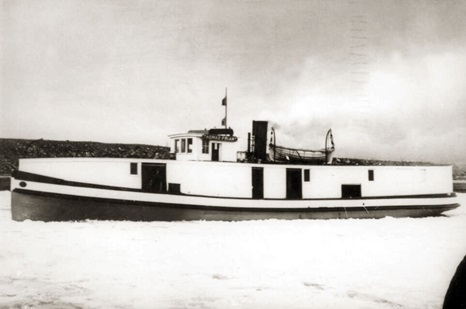
The Day Lake Superior Gave Up Her Dead
The Jones family of Cornucopia, Wisconsin, was well known as both boatbuilders and commercial fishermen on Lake Superior. Thomas Senior and his two sons, Thomas Jr. “Coonie” and Emery, made good money in the fall of 1924 when the price of herring was unusually high.The price of trout was also high at the time, and the men knew they could make even better money if only they could fish trout on the Big Lake after herring season  closed. Overwinter fishing on the open Lake had never been done out of the small harbors of the South Shore. Another problem was, the Joneses didn’t have a proper boat capable of staying out beyond the pack ice for any length of time. Enter the Thomas Friant, a 96-by-18-foot abeam, 81-ton wooden hulled ferry built in Grand Haven, Michigan, in 1884. The passenger-hauling Friant had been converted to a massive – for that era – fishing tug. photos, more, >>CLICK TO READ<< 09:06
closed. Overwinter fishing on the open Lake had never been done out of the small harbors of the South Shore. Another problem was, the Joneses didn’t have a proper boat capable of staying out beyond the pack ice for any length of time. Enter the Thomas Friant, a 96-by-18-foot abeam, 81-ton wooden hulled ferry built in Grand Haven, Michigan, in 1884. The passenger-hauling Friant had been converted to a massive – for that era – fishing tug. photos, more, >>CLICK TO READ<< 09:06
Crab fishermen test pop-up fishing gear to reduce whale entanglements
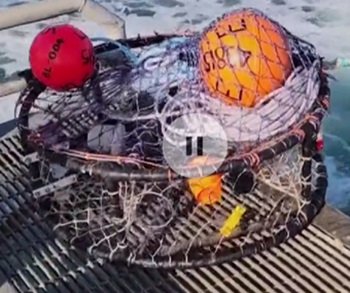 Traditionally, the Dungeness crab fishing season runs from November through June using vertical line fishing gear that spans from the surface to the seafloor. After whale entanglements spiked from 2015 to 2018, the Dungeness crab season has faced delay or closure since 2019. Season closures are affecting the fishing business, but now during this closure, a handful of commercial fishermen such as Brand Little, are testing a whale-safe kind of fishing gear, called “pop-up” or “ropeless” fishing gear, hoping the state will authorize this alternative for use next season, so fishermen can still work. Commercial fisherman Brand Little described how the first test of the spring season went with about 20 fishermen. Video, more, >>CLICK TO READ<< 08:59
Traditionally, the Dungeness crab fishing season runs from November through June using vertical line fishing gear that spans from the surface to the seafloor. After whale entanglements spiked from 2015 to 2018, the Dungeness crab season has faced delay or closure since 2019. Season closures are affecting the fishing business, but now during this closure, a handful of commercial fishermen such as Brand Little, are testing a whale-safe kind of fishing gear, called “pop-up” or “ropeless” fishing gear, hoping the state will authorize this alternative for use next season, so fishermen can still work. Commercial fisherman Brand Little described how the first test of the spring season went with about 20 fishermen. Video, more, >>CLICK TO READ<< 08:59
A submerged concern: offshore wind cables
 As offshore wind turbines undergo construction in waters south of the Vineyard, and with some already standing and delivering power, the debates on the Island regarding the industry continue. John Keene, president of the Martha’s Vineyard Fishermen’s Preservation Trust, told the Times that some in the fishing industry are nervous about how the electromagnetic field from the cables can affect marine life. Keene said the concern is that the fields emitted from cables could act like a fence, particularly for migratory species, and impact the behavior of marine species. “There’s a lot of unknowns,” he said. more, >>CLICK TO READ<< 07:14
As offshore wind turbines undergo construction in waters south of the Vineyard, and with some already standing and delivering power, the debates on the Island regarding the industry continue. John Keene, president of the Martha’s Vineyard Fishermen’s Preservation Trust, told the Times that some in the fishing industry are nervous about how the electromagnetic field from the cables can affect marine life. Keene said the concern is that the fields emitted from cables could act like a fence, particularly for migratory species, and impact the behavior of marine species. “There’s a lot of unknowns,” he said. more, >>CLICK TO READ<< 07:14
Atlantic fisheries body confirms cyber incident after 8Base ransomware gang claims breach
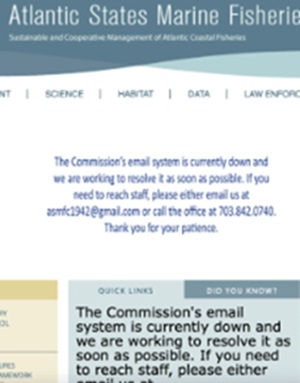 A fisheries management organization for the East Coast is dealing with a cyber incident following claims by a ransomware gang that it stole data. The Atlantic States Marine Fisheries Commission (ASMFC) — an 80-year-old organization created by Congress and made up of officials from the Atlantic coast states — said this week that its email system is down. The organization was forced to create a temporary email address and provide a phone number people can use to contact the information. Tina Berger, director of communications for ASMFC, told Recorded Future News that they are currently “responding to a cyber incident affecting our systems” but did not respond to further questions about whether they are dealing with a ransomware attack. more, >>CLICK TO READ<< 15:04
A fisheries management organization for the East Coast is dealing with a cyber incident following claims by a ransomware gang that it stole data. The Atlantic States Marine Fisheries Commission (ASMFC) — an 80-year-old organization created by Congress and made up of officials from the Atlantic coast states — said this week that its email system is down. The organization was forced to create a temporary email address and provide a phone number people can use to contact the information. Tina Berger, director of communications for ASMFC, told Recorded Future News that they are currently “responding to a cyber incident affecting our systems” but did not respond to further questions about whether they are dealing with a ransomware attack. more, >>CLICK TO READ<< 15:04
Three fishermen forced into life raft as trawler starts sinking
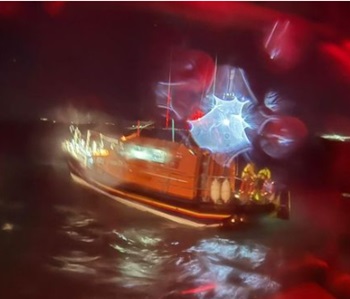 RNLI teams from Exmouth and Torbay carried out a joint rescue mission after three fishermen found themselves in peril when their trawler began sinking. At 9.32pm last night, Tuesday, April 16, HM Coastguard requested the launch of both the Exmouth and Torbay RNLI lifeboats, having received an urgent mayday call. The brevity of the desperate plea was spine-chilling as the message simply stated: “fishing vessel sinking”. This alarming report was quickly followed by a 999 call confirming that all three crew had taken to the vessel’s life raft. Photos, more, >>CLICK TO READ<< 10:36
RNLI teams from Exmouth and Torbay carried out a joint rescue mission after three fishermen found themselves in peril when their trawler began sinking. At 9.32pm last night, Tuesday, April 16, HM Coastguard requested the launch of both the Exmouth and Torbay RNLI lifeboats, having received an urgent mayday call. The brevity of the desperate plea was spine-chilling as the message simply stated: “fishing vessel sinking”. This alarming report was quickly followed by a 999 call confirming that all three crew had taken to the vessel’s life raft. Photos, more, >>CLICK TO READ<< 10:36
Alaska delusions – The great takeover of federal waters
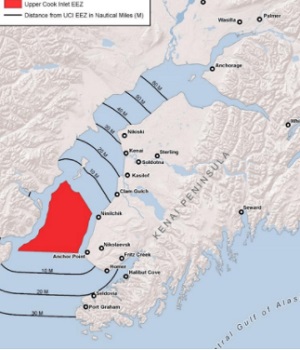 Oh if only the facts were as a trio of Alaska House legislators would like their colleagues to believe. They’ve drafted a resolution calling on Congress to extend state waters to 15 miles off the coast of Alaska because this would serve the state’s interest in supporting a “seafood industry generat(ing) over $163,000,000 in revenue for state and local governments.” All those zeros make that look like a great deal of money, but in terms of state revenue, $163 million is chicken feed. The state’s now fading oil industry is forecast to produce $3 billion in fiscal year 2024 or almost 20 times more, according to state projections. Worse though, the claim to $163 million in state revenue from the fishing industry comes from a report compiled for the Alaska Seafood Marketing Institute (ASMI) that is badly outdated, and the resolution now based on that report lacks the context which even the seafood sales promotion organization felt compelled to add. more, >>CLICK TO READ<< 08:56
Oh if only the facts were as a trio of Alaska House legislators would like their colleagues to believe. They’ve drafted a resolution calling on Congress to extend state waters to 15 miles off the coast of Alaska because this would serve the state’s interest in supporting a “seafood industry generat(ing) over $163,000,000 in revenue for state and local governments.” All those zeros make that look like a great deal of money, but in terms of state revenue, $163 million is chicken feed. The state’s now fading oil industry is forecast to produce $3 billion in fiscal year 2024 or almost 20 times more, according to state projections. Worse though, the claim to $163 million in state revenue from the fishing industry comes from a report compiled for the Alaska Seafood Marketing Institute (ASMI) that is badly outdated, and the resolution now based on that report lacks the context which even the seafood sales promotion organization felt compelled to add. more, >>CLICK TO READ<< 08:56
Athearn Marine Agency Boat of the Week: 57′ Aluminum Dragger, Cummins KT-1150, State and Federal Permits
 To review specifications, information, and 25 photos’, >click here<, To see all the boats in this series, >click here< 07:18
To review specifications, information, and 25 photos’, >click here<, To see all the boats in this series, >click here< 07:18
Torbay RNLI assists trawler with total loss of power in heavy seas at 04:00am
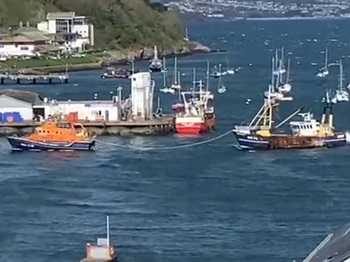 On Monday 15th April 2024 at 03:23am Solent Coastguard requested Torbay RNLI launch to assist a 100-ton beam trawler who had got into some difficulties 15 miles southeast of Berry Head. She had suffered a complete loss of power. Pagers went off and our volunteer crew duly assembled at the station, changed into wet-weather gear, made ready the All-weather Lifeboat (ALB) and launched at 03:45am. Weather and sea conditions early this morning, especially 15 miles into the Channel, were challenging. Force 7 gusting 8/9, north westerly winds, and choppy seas. Loss of both engine and generator power in these conditions meant the trawler and all her associated gear, would be unwieldly and vulnerable to the turbulent and freshening conditions. She was very much what is termed a ‘dark ship’. Photos, more, >>CLICK TO READ<< 16:39
On Monday 15th April 2024 at 03:23am Solent Coastguard requested Torbay RNLI launch to assist a 100-ton beam trawler who had got into some difficulties 15 miles southeast of Berry Head. She had suffered a complete loss of power. Pagers went off and our volunteer crew duly assembled at the station, changed into wet-weather gear, made ready the All-weather Lifeboat (ALB) and launched at 03:45am. Weather and sea conditions early this morning, especially 15 miles into the Channel, were challenging. Force 7 gusting 8/9, north westerly winds, and choppy seas. Loss of both engine and generator power in these conditions meant the trawler and all her associated gear, would be unwieldly and vulnerable to the turbulent and freshening conditions. She was very much what is termed a ‘dark ship’. Photos, more, >>CLICK TO READ<< 16:39
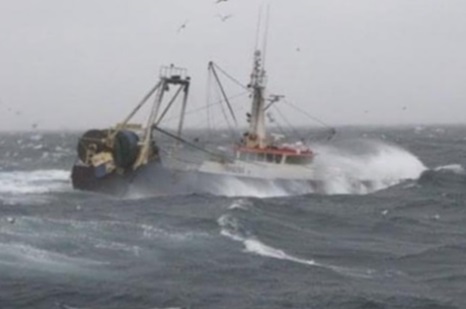
More things to worry about by Jerry Leeman
Wind energy in the Gulf of Maine is going to be a great challenge to all varieties of commercial and recreational fisheries. What disturbs me the most is, in all my travels along the coast in the four major fishing ports in New England, very few commercial fishing Captains were aware of the new talks on changing the management stock areas and the reallocation of codfish. This is a concern for many now that they are aware. This raises the question, if no Captain’s that fish inside the Wind Energy proposed areas were not aware of this future action, then how can the last comment periods on the proposed sights be accurately sighted? Charts graphs, more, >>click to read<< 13:16
Maine researchers, students are sorting through muck and slugs to study baby scallops
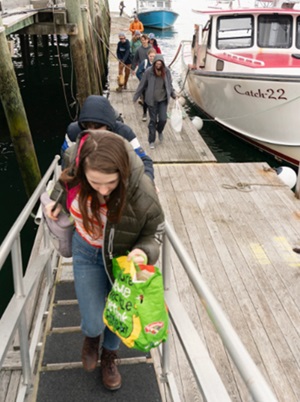 People from each of these groups are collaborating with the Maine Center for Coastal Fisheries, Hurricane Island Center for Science and Leadership and Colby College in the second year of a study meant to help identify how many young scallops there are off Maine’s coast, and where they’re living. The tiny, two-shelled juveniles, or spat, are uniquely important to fishermen who scoop wild scallops from the ocean floor and aquaculture farmers who raise them in contained areas. Unlike most aquaculture farmers who work with other species, scallop farmers can only grow their bounty from wild spat – the same spat that wild scallop fishermen need to feed the general population. Photos, more, >>click to read<< 12:50
People from each of these groups are collaborating with the Maine Center for Coastal Fisheries, Hurricane Island Center for Science and Leadership and Colby College in the second year of a study meant to help identify how many young scallops there are off Maine’s coast, and where they’re living. The tiny, two-shelled juveniles, or spat, are uniquely important to fishermen who scoop wild scallops from the ocean floor and aquaculture farmers who raise them in contained areas. Unlike most aquaculture farmers who work with other species, scallop farmers can only grow their bounty from wild spat – the same spat that wild scallop fishermen need to feed the general population. Photos, more, >>click to read<< 12:50
IS THE G.A.O. SLOWWALKING ITS INVESTIGATION OF OFFSHORE WIND IMPACTS? By Jim Lovgren
 On June 15, 2023, Congressman Chris Smith issued a press release touting the acceptance by the General Accountability Office [GAO], of a request by the House Natural Resources Committee to investigate a wide range of issues related to the development of offshore wind. The Committee letter, signed by Chairman Bruce Westerman, was submitted on May 15 th , 2023, almost a year ago. I bring this up because the average time-length of most GAO investigations is three months. Which begs the question; Is the Biden administration “slow-walking” the GAO investigation? Slow-walking is the act of purposefully delaying action by stalling, stonewalling, making excuses of how hard it is to do, and other whiney efforts at delaying an investigation until it fails because it is too late. It is the bureaucrat’s favorite weapon of choice when forced to disclose vital information, that their politician benefactors don’t want exposed. more, >>click to read<< 06:10
On June 15, 2023, Congressman Chris Smith issued a press release touting the acceptance by the General Accountability Office [GAO], of a request by the House Natural Resources Committee to investigate a wide range of issues related to the development of offshore wind. The Committee letter, signed by Chairman Bruce Westerman, was submitted on May 15 th , 2023, almost a year ago. I bring this up because the average time-length of most GAO investigations is three months. Which begs the question; Is the Biden administration “slow-walking” the GAO investigation? Slow-walking is the act of purposefully delaying action by stalling, stonewalling, making excuses of how hard it is to do, and other whiney efforts at delaying an investigation until it fails because it is too late. It is the bureaucrat’s favorite weapon of choice when forced to disclose vital information, that their politician benefactors don’t want exposed. more, >>click to read<< 06:10
Where Have All The Right Whales Gone?
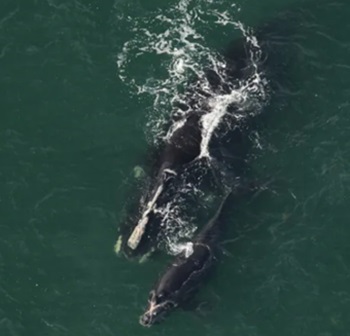 Marine researchers have mapped the density of one of the most endangered large whale species worldwide, the North Atlantic right whale, using newly analyzed data to predict and help avoid whales’ harmful, even fatal, exposure to commercial fishing and vessel strikes. Duke University’s Marine Geospatial Ecology Lab led a collaboration of 11 institutions in the United States that pooled 17 years of available visual survey data covering 9.7 million square kilometers of the U.S. Atlantic – roughly the same area as the entire contiguous United States. more, >>click to read<< 16:37
Marine researchers have mapped the density of one of the most endangered large whale species worldwide, the North Atlantic right whale, using newly analyzed data to predict and help avoid whales’ harmful, even fatal, exposure to commercial fishing and vessel strikes. Duke University’s Marine Geospatial Ecology Lab led a collaboration of 11 institutions in the United States that pooled 17 years of available visual survey data covering 9.7 million square kilometers of the U.S. Atlantic – roughly the same area as the entire contiguous United States. more, >>click to read<< 16:37
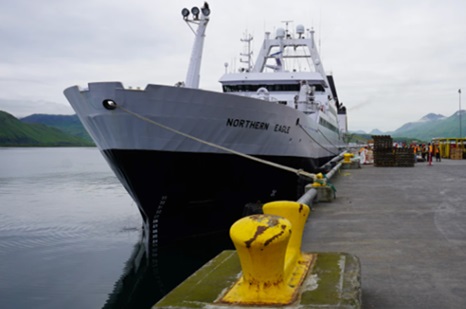
Fishery council seeks more information before deciding on chum bycatch in Bering Sea pollock fishery
The North Pacific Fishery Management Council, which manages federal fisheries in Alaska, will continue to explore options for how to manage chum salmon bycatch in the Bering Sea pollock fishery. The council, facing rising pressure from western Alaska communities who depend on chum as a cornerstone of subsistence, released a statement Wednesday summarizing their decision from their April meeting. Dismal western Alaska salmon returns have reached crisis levels. And while the council listened to scores of harrowing testimonies recalling empty rivers and vacant fish camps, the council was also presented with research that suggested bycatch limits wouldn’t do much to help the crisis. “Available science indicates recent declines in chum salmon populations across many regions of the North Pacific, including Canada, Japan, Russia, Korea, and the U.S., appear to be driven by warmer water temperatures in both the marine and freshwater environments,” the council said in the statement. more, >>click to read<< 12:38
An ocean of ambition
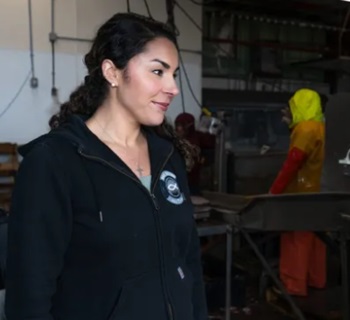 One by one, a trustee listed the assets up for sale: eight commercial fishing vessels and 48 federal fishing permits. It was a fire-sale liquidation for bankrupt Blue Harvest Fisheries — one of New England’s largest seafood companies — and the largest bundle of groundfish permits in recent history to come available on the market. Bids, the trustee announced, would start at $10 million. Cassie Canastra was first to act: “$11 million,” she said, without skipping a beat. There was a brief pause, as a team representing O’Hara Corporation, part owner of New Bedford-based scallop giant Eastern Fisheries, huddled to discuss their options. They raised the bid to $11.25 million. “$12 million,” Canastra responded, showing no sign of relenting. Photos, more, >>click to read<< 11:03
One by one, a trustee listed the assets up for sale: eight commercial fishing vessels and 48 federal fishing permits. It was a fire-sale liquidation for bankrupt Blue Harvest Fisheries — one of New England’s largest seafood companies — and the largest bundle of groundfish permits in recent history to come available on the market. Bids, the trustee announced, would start at $10 million. Cassie Canastra was first to act: “$11 million,” she said, without skipping a beat. There was a brief pause, as a team representing O’Hara Corporation, part owner of New Bedford-based scallop giant Eastern Fisheries, huddled to discuss their options. They raised the bid to $11.25 million. “$12 million,” Canastra responded, showing no sign of relenting. Photos, more, >>click to read<< 11:03



































